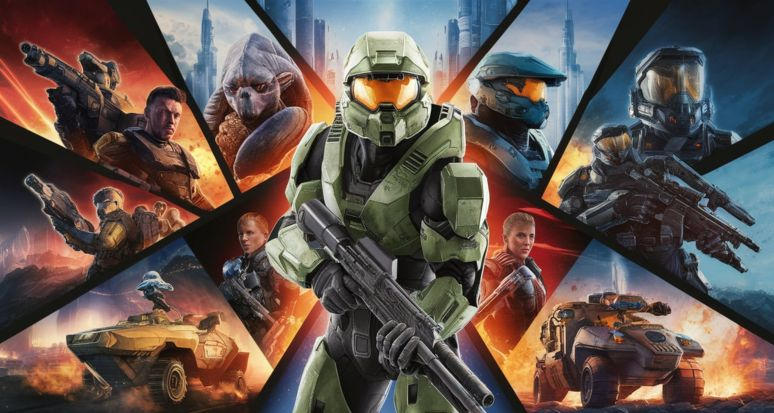Halo (2003) Game Icons Banners: A Nostalgic Look at Classic Visual

The release of Halo: Combat Evolved in 2003 was a landmark moment in gaming history. As one of the most iconic titles of the early 2000s, it not only revolutionized the first-person shooter (FPS) genre but also brought with it a slew of memorable game icons and banners that have since become timeless symbols for gamers. These visuals were essential to creating the legendary atmosphere of Halo and played a key role in building the franchise’s identity. halo (2003) game icons banners.
In this article, we’ll dive deep into the Halo (2003) game icons banners, analyzing their design, significance, and lasting impact on the gaming community.
The Role of Game Icons in Halo’s Identity
Icons are more than just visual markers. They represent the game’s brand, providing immediate recognition and helping players associate the symbols with their in-game experiences. Halo: Combat Evolved had its share of iconic imagery, with many elements becoming synonymous with the franchise itself.
The Iconic Halo Logo
At the center of the game’s identity was the Halo logo. The word “Halo” itself was wrapped in a futuristic metallic font, exuding both simplicity and strength. It symbolized the ringworld – the “Halo” in the game’s universe – which is central to the storyline. This logo would become instantly recognizable to fans, forming the basis for subsequent marketing campaigns and merchandise.
This icon, often seen in game banners and promotional art, became one of the most well-known symbols in gaming, and it set the stage for every title that followed in the series. The strength of this branding element ensured that fans could easily identify a Halo game at a glance.
Master Chief’s Helmet – A Visual Representation of Heroism
No discussion about Halo (2003) game icons banners would be complete without mentioning the helmet of Master Chief. The green armor and helmet have become the face of the franchise. Seen on everything from game covers to posters, Master Chief’s helmet is the ultimate symbol of the Halo series.
In the game’s banners and promotional material, the helmet was often featured prominently, suggesting a lone, heroic figure ready to face insurmountable odds. For players, seeing this icon evoked a sense of excitement and nostalgia, reminding them of their in-game experiences and triumphs.
Banners and Their Importance in Marketing Halo (2003)
The Halo franchise is renowned not only for its gameplay but also for its clever marketing strategies. Banners, whether digital or physical, were key components in creating anticipation for the game. The visuals featured in these banners helped set the tone for the player’s experience, creating an immersive world before they even picked up the controller.
Promotional Art and Its Impact
In the lead-up to the release of Halo: Combat Evolved, banners were everywhere. They featured dramatic action scenes with Master Chief at the forefront, often set against vast alien landscapes that showcased the ringworld’s grandeur. These banners were more than just promotional tools; they offered players a glimpse into the game’s universe, heightening their anticipation and engagement.
The backgrounds in these banners were often adorned with starry skies, towering structures, or the iconic “Halo” itself, emphasizing the game’s space opera setting. The contrast between the futuristic armor of Master Chief and the natural, yet alien, landscapes created a striking visual appeal, one that drew players into the immersive world that Bungie had crafted.
The Power of Digital Banners
With the rise of the internet in the early 2000s, digital banners became a powerful marketing tool for games. Halo: Combat Evolved capitalized on this, ensuring that its banners were plastered across gaming websites, forums, and social media platforms. These banners often featured a mix of in-game footage, iconic symbols, and call-to-action buttons, inviting players to learn more about the game or pre-order it before release.
The early 2000s saw the beginning of banner advertisements on gaming platforms, and Halo was at the forefront of this shift. The digital banners helped expand the game’s reach beyond traditional media and allowed it to capture the attention of a broader, more diverse audience.
The Legacy of Halo’s Visuals
Nearly two decades after the release of Halo: Combat Evolved, the icons and banners from the 2003 launch still evoke a sense of nostalgia in gamers. The imagery has stood the test of time, largely due to its minimalist yet striking design. Today, fans of the franchise continue to collect and display posters, banners, and other memorabilia featuring the iconic logos and symbols from the original game.
Moreover, these icons have inspired countless fan artworks, remakes, and homages. Master Chief’s helmet, the Halo ringworld, and the futuristic fonts used in the promotional material are all deeply ingrained in gaming culture.
See Also Read: Halo (2003) Game Icons Banners.
Final Thoughts: The Enduring Appeal of Halo (2003) Game Icons Banners
The Halo (2003) game icons banners were more than just marketing tools; they were symbols that defined a generation of gamers. Through carefully crafted visuals, Halo established itself not just as a game, but as a cultural phenomenon. The banners and icons from Halo: Combat Evolved are a testament to the power of visual design in creating a lasting brand identity in the gaming world.
As we look back at the legacy of Halo and its impact on the gaming industry, it’s clear that these iconic visuals played a significant role in shaping the way fans remember the game. From the instantly recognizable Master Chief helmet to the futuristic logo, the banners and icons of Halo (2003) continue to resonate with players today, solidifying the franchise’s place in video game history.